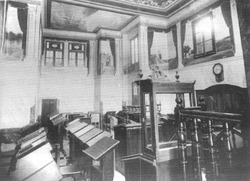Shaar Hashamayim Yeshiva
| Shaar Hashamayim Yeshiva ישיבת שער השמים | |
|---|---|
 Interior of the Old City building, 1920s | |
| Address | |
 | |
71 Rashi St. | |
| Coordinates | 31°47′15.54″N 35°12′39.71″E / 31.7876500°N 35.2110306°E |
| Information | |
| Established | 1906 |
| Rosh Yeshiva | Rabbi Reuven Gross Rabbi Gamliel Rabinowitz |
| Affiliation | Haredi |
Shaar Hashamayim Yeshiva (
Name
The name of the yeshiva was taken from the
Origins

The impetus to found Shaar Hashamayim Yeshiva came from a dream experienced by two noteworthy Jerusalem rabbis on the same night in 1906. Rabbi
The yeshiva opened shortly afterwards in the
Curriculum
In 1924, the yeshiva published a pamphlet describing its aims and approach as follows:
First, the study of the revealed Torah, as it is studied in all the holy yeshivot, [including]
mussarand inquiry. [This is] the only place in the world where the Torah of kabbalah is studied in an orderly manner, progressing from simple teachings to more difficult ones, taught by talmidei chachamim who are qualified for the task. …
The yeshiva's intention is not to provide its students with a simple, superficial understanding of the works of kabbalah, to afford a mere glimpse, wherein lies the danger of stumbling — as Chazal put it, "He glimpsed and was injured." Only extensive inquiry and in-depth study of all the kabbalah works ensures full, rounded knowledge. This is what Yeshivas Shaar HaShamayim and its branches aim to provide.[1]
Then as now, kabbalists who wish to study at the yeshiva must demonstrate extensive knowledge of the revealed Torah, and spend half the day in the yeshiva learning the revealed Torah. The yeshiva offers daily
Student body
One of the first students in the new yeshiva was Rabbi Tzvi Pesach Frank, a dayan (rabbinical judge) on the Jerusalem beit din (rabbinical court) and future Chief Rabbi of Jerusalem. The yeshiva has produced a number of Torah scholars, Torah disseminators and rabbis. It has also published many works on kabbalah.[1]
Destruction and relocation

Shaar Hashamayim Yeshiva operated at 1 Gal'ed Street in the
Shaar Hashamayim Yeshiva next moved to the Beit Yisrael neighborhood, occupying the building that now houses the shtieblekh. In 1958, the yeshiva moved to Rashbam Street in the Mekor Baruch neighborhood.[1]
When Rabbi Refoel Dovid Auerbach became the
(In recent years, a building addition on the top rear story covered over three of the thirteen windows there.)Leadership
The first roshei yeshiva of Shaar Hashamayim Yeshiva were the founders, Rabbi Chaim Yehuda Leib Auerbach and Rabbi Shimon Horowitz. Auerbach chose to stay with the yeshiva even after his father, the Admor of Chernowitz-Chmielnik, died and his Hasidim asked Auerbach to take his father's place. He declined, leaving the position of Admor unfulfilled.[1]
Following Auerbach's death in 1954, his son, Rabbi Eliezer Auerbach, led the yeshiva for many years. After his death, another of Auerbach's sons, Rabbi Refoel Dovid Auerbach, assumed leadership. Subsequent roshei yeshiva were Rabbi Aharon Slotkin (who died in 1973), Rabbi Yechiel Fishel Eisenbach (who served from 1973 until his death in 2008), and the current roshei yeshiva, Rabbi Yaakov Meir Shechter and Rabbi Gamliel Rabinowitz.[1]
Auerbach's eldest son, Rabbi Shlomo Zalman Auerbach, served as president of the yeshiva; after his death, his son, Rabbi Shmuel Auerbach, succeeded him. Rabbi Shlomo Zalman's nephew, Rabbi Yakov Schlaff, acts as yeshiva administrator.[1]
Public events
Shaar HaShamayim Yeshiva invites the public to participate in special yeshiva events during the year. The most popular is the Thursday
Shaar HaShamayim Yeshiva has increased public awareness of the yahrzeit of the Arizal on 5 Av, and reintroduced the custom of visiting his gravesite in Safed on that day.[1]
See also
- Beit El Synagogue
References
- ^ a b c d e f g h i j k l m n o p Gefen, Rabbi Aryeh (20 September 2006). "A Century Since the Founding of Yeshivas Shaar HaShomayim - 5666-5766". Dei'ah VeDibur. Retrieved 23 January 2010.
- ^ Rossoff, Dovid (2005). קדושים אשר בארץ: קברי צדיקים בירושלים ובני ברק [The Holy Ones in the Earth: Graves of the Righteous in Jerusalem and Bnei Brak] (in Hebrew). Jerusalem: Machon Otzar HaTorah. p. 425.
- ISBN 0-87306-879-3.
- ^ Rossoff, Where Heaven Touches Earth, p. 403.
Further reading
- Jonatan Meir, "The Imagined Decline of Kabbalah: The Kabbalistic Yeshiva Sha'ar ha-Shamayim and Kabbalah in Jerusalem in the Beginning of the Twentieth Century" in Kabbalah and Modernity. Boaz Huss, Marco Pasi, and Kocku von Stuckrad, eds. Brill: Leiden & Boston, 2010, pp. 197–220.
- Jonatan Meir, "Rehovot ha-Nahar: Kabbalah and Exotericism in Jerusalem (1896-1948)". Jerusalem: Yad Yitzhak Ben Zvi, 2011.
- Jonatan Meir, "Toward the Popularization of Kabbalah: R. Yosef Hayyim of Baghdad and the Kabbalists of Jerusalem", Modern Judaism 33(2) (May 2013), pp. 147–172
